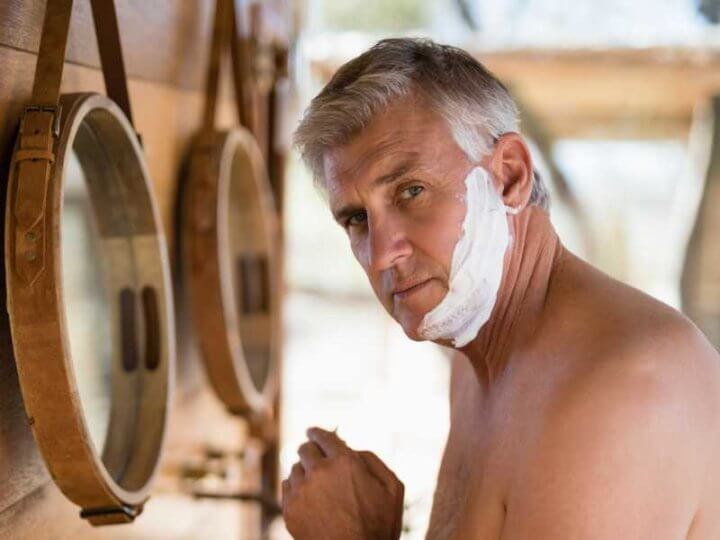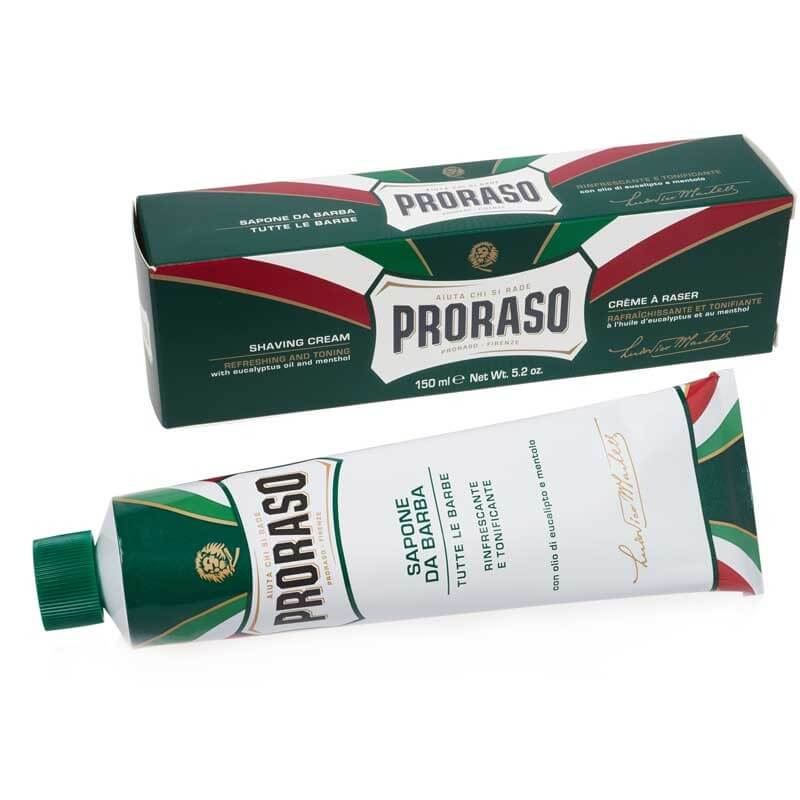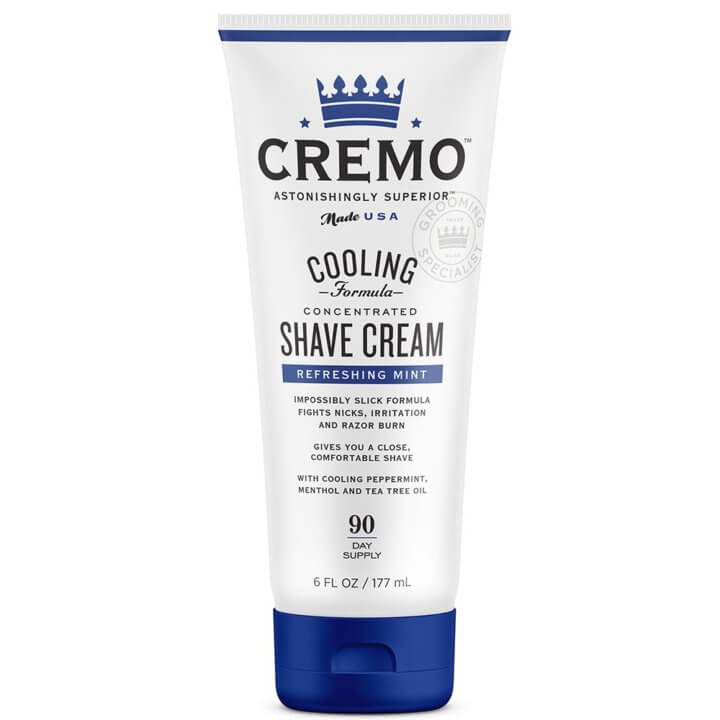
Shaving creams are designed to provide a smooth shaving experience by lubricating the skin and protecting against razor burn. However, some shaving creams also contain anesthetics, which can numb the skin and reduce pain during shaving.
While anesthetics may offer some benefits, they also come with risks. For example, they may increase the risk of cuts or nicks due to reduced sensation in the area being shaved. Anesthetics can also cause allergic reactions in some people.
Before using a shaving cream with an anesthetic, it is important to weigh the potential risks and benefits. Here is an overview of the pros and cons of using anesthetics in shaving creams.
How Does A Shaving Cream Work?
Shaving creams usually consist of an emulsion of oils, soaps or surfactants, and water which helps to hydrate facial hair and soften tough hairs, making them easier to cut. Additionally, the humectant properties of the shaving cream help to retain moisture in the skin, reduce irritation and exfoliate dead skin cells which can help reduce the appearance of ingrown hairs.
What Are The Benefits Of Using A Shaving Cream With An Anesthetic?
- Can reduce skin irritation and discomfort during shaving.
- Can improve the quality of the shave, resulting in fewer ingrown hairs and razor bumps.
- Can help reduce the appearance of existing razor bumps and ingrown hairs.
- Can help prevent the formation of new razor bumps and ingrown hairs.
- Can be used in combination with sunburn treatments, such as aloe vera gel.
- Can be used in combination with other skincare products, such as a moisturizing lotion.
- Can be used in combination with other pain relievers, such as ibuprofen.
- Can help to reduce the discomfort of shaving sensitive areas, such as the bikini line.
- Can be used in combination with other shaving techniques, such as applying a pre-shave oil beforehand.
What Are The Risks Of Using A Shaving Cream With Anesthetic?

While there may be some benefits to a shaving cream with a skin numbing agent, there are a number of risks as well, depending on the concentration of the ingredient.
- May cause skin irritation and rash
- May cause an allergic reaction
- May cause a more painful shave by increased pressure on the razor, which results in more nicks, scratches, and razor burn.
- May cause a higher risk of developing razor bumps because it can prevent you from feeling nicks and scratches, which can lead to more severe cuts.
- May cause a higher risk of developing redness due to irritation or inflammation caused by the anesthetic.
What Topical Anesthetics Are Found In Shaving Creams?
Shaving products (particularly in the “megamart” mass-market) sometimes take advantage of topical anesthetics to mask ingredients that might cause irritation or provide less effective lubrication in the shave. However the use of topical anesthetics in shaving creams has fallen dramatically over the past ten years or so. But there are still some products that use them–including one ingredient the traditional wet shaver might be quite familiar with. Here is an overview of topical anesthetics that might be found in shaving creams:
Shaving Cream With Benzocaine
Benzocaine is a local anesthetic that was sometimes used in shaving products. However, it is metabolized to p-aminobenzoic acid and can be hazardous if not used correctly. Use of Benzocaine and its derivatives in shaving creams is fairly rare now, though you might find it in some post-shave products.
Shaving Cream With Lidocaine
Lidocaine was another topical anesthetic used in over-the-counter shave products to reduce pain and irritation. It is safe, unscented, paraben-free, and not tested on animals.
Like Benzocaine, Lidocaine’s use in shaving creams is not as common as it once was, though one shaving cream found on Amazon is still a favorite with certain customers. It is also found in some post-shave products.
Shaving Cream With Menthol
Menthol is an organic compound obtained by freezing peppermint oil.
Menthol has local anesthetic and “counter-irritant” qualities. Menthol seems to activate GABA (gamma amino butyric acid) receptors in the brain and spinal cord, interfering with pain reception. Menthol is also a weak kappa opioid receptor activator, likely causing release of pain killing compounds in the brain.
Menthol also activates the body receptor structures found in the skin and other cold sensitive areas for “feeling cold.” Menthol tricks these cold receptors into believing they sense cold. While it does not actually change the temperature of the skin, it produces a cooling effect in conjunction with its local anesthetic properties.
Related Post: What is Menthol And Why Is It In My Shaving Stuff?
There are a number of mentholated shave creams and soaps available. Here is a sampling (Amazon links are affiliate):

The obvious, classic shave cream with Menthol (especially familiar to wet shavers) is Proraso “Refreshing And Toning” (with Eucalyptus and Menthol) in the green packaging. Proraso is one of the most recognized names in traditional wet shaving and a best seller for many years. Low-cost, mildly cooling, and popular, I doubt if there is anyone reading this who has not at least heard of (if not used) Proraso “Refreshnig And Toning” or it’s near copy from C.O. Bigelow.

Cremo Cooling is another popular shave cream with Menthol. I find Cremo Cooling to be not only a nicely cooling brushless cream but an excellent over-all performer as well. The cream itself is rich but not heavy, and it’s based on high-quality ingredients including aloe, macadamia seed oil, calendula extract, lemon extract, papaya extract, and olive leaf extract.
In addition to mass-market products there are many artisan shave soaps that contain Menthol. Some that contain fairly high levels of it include (more on ingredient concentration later):
Chiseled Face Cryogen – The Cryogen by is a tallow-based shaving soap that’s loaded with menthol, offering a very cold, tingling shave. The soap lathers easily and smoothly. The menthol scent is intense, and you’ll find yourself puckering and your eyes watering every time you take a drag.
Noble Otter Orbit – I have to hand it to Noble Otter, Orbit is a truly fantastic shaving soap. The scent doesn’t overpower the blend with the additional notes of bergamot, eucalyptus, and cedarwood. The lather is thick, and creamy. The soap was easy to whip up, and shave well without leaving any residue. Orbit uses a synthetic menthol that will last longer and not create so much of a “burning cold” feeling.
PAA Frost Byte – The menthol is intense, and the Tea Tree added a nice touch. Also available in their “super premium” CK6 formula base.
Stirling Glacial Line – Stirling Soap offers a number of mentholated shave soaps and their “Glacial” line ups the cooling factor considerably.
How To Choose The Right Shaving Cream For You?

Given all the data above, how do you choose the right shaving cream? Here are some general suggestions.
Choose A Shaving Cream Based On Your Needs
Consider your skin type: If you have sensitive skin, look for a shaving cream that contains moisturizers to protect it from irritation.
Related Post: What Is The Best Shaving Cream For Men At Every Price Point In 2023?
Consider The Content And Concentration Of Ingredients
Look at ingredients: Make sure to read the ingredients list before buying any shaving cream so that you know what kind of effects it might have on your skin and how best to use it accordingly (e.g., if there are any alcohols listed in an otherwise good product).
It is also important to contrast the content and concentration of ingredients in shaving creams since not all products are created equal. Some products may be more concentrated than others or have higher levels of certain active ingredients that could cause irritation if not used properly or according to instructions on the label. It is important to read all labels thoroughly before using any product so that you can understand how best to use it without any adverse effects from improper application or usage instructions from manufacturer’s website.
Check User Reviews And Comments
Checking user reviews and comments can help you choose the right shaving cream for you: it gives an insight into the product, its pros and cons, and customer experiences.
This allows you to make an informed decision about whether or not the product is right for you based on real customer feedback. You can also see what other people find useful or disappointing about it, which can help inform your purchasing decision.
Evaluate The Effectiveness Of The Product In Terms Of Performance
1. Identify the target customer base for the shaving cream product. Who are you trying to reach with your product?
2. Research customer reviews and ratings of similar products in your industry to understand what customers look for in a good shaving cream.
3. Analyze the feedback from customers on your product, including both positive and negative comments, to determine how successful it is at meeting their needs and expectations.
4. Compare your product’s star rating with other products in the same category to see how it stacks up against competitors’ offerings or if there are areas where improvements can be made based on customer reviews/ratings criteria such as effectiveness, smell/taste/feel etc..
5.. Adjust packaging or marketing materials if necessary so that they accurately represent what customers expect from a quality shaving cream experience .
FAQ
What Ingredients Should I Avoid In Shaving Cream?
Many traditional shaving creams contain potentially harmful ingredients like triethanolamine (TEA), sodium lauryl sulphate (SLS) and sodium laureth sulphate (SLES), butylated hydroxytoluene (BHT) and fragrance, myristic acid and sorbitol.
It’s best to choose a shaving cream that contains natural, non-toxic ingredients that are safe for both you and the environment. Many organic brands offer natural alternatives made with ingredients like shea butter and essential oils that help to nourish skin and prevent irritation. By reading labels carefully and avoiding potentially harmful ingredients, you can ensure that your daily shave is both smooth and safe.
Overall, while many shaving creams contain potentially harmful chemicals, it is important to remember that in most cases, these chemicals are present in very small amounts and pose little risk.
About The Author: Otto Wright is a wet shaver and budding author.

Great posting! So which shave creams use an anesthetic other than menthol?
Mark, you look great covered in shaving cream. I think you might see a doctor for those dark circles under you eyes.
shhhhhhh. . . . yeah I know it is not you.
Dartan
LOL
Comments are closed.